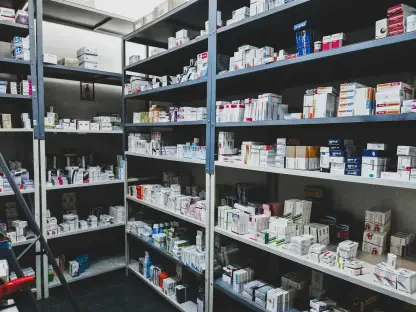The 2024 Nightingale Awards in product design for healthcare facilities showcased remarkable advancements, according to the comprehensive report from the Healthcare Design Conference + Expo held in Indianapolis. The event highlighted innovative solutions recognized by the awards, providing insights from jurors and reflecting market demands influencing these innovations. This article delves into the current state and future directions of healthcare facility products, capturing perspectives from industry experts.
Innovation in Product Design
Addressing Operational and Clinical Challenges
The Nightingale Awards spotlighted products that tackle real-world problems in healthcare settings. Innovations such as the CoWin Digital Media Wall, which supports de-escalation in behavioral health settings, and Standard Textile’s AMY Privacy Curtain, which enhances room turnover efficiency, were among the notable examples. These products are designed to improve operational efficiency and clinical effectiveness, addressing issues like staffing shortages and patient privacy. These solutions are not just incremental improvements but represent significant advancements in how healthcare facilities operate day-to-day. For instance, the CoWin Digital Media Wall provides a unique way to manage patient behavior in stressful environments, thereby reducing the need for physical restraints and enhancing overall patient care. Similarly, the AMY Privacy Curtain improves room turnaround times, allowing facilities to accommodate more patients without compromising privacy or hygiene standards.
The emphasis on addressing both operational and clinical challenges means that the awarded products have a direct and immediate impact on the daily functioning of healthcare environments. By solving issues such as staffing shortages and enhancing patient privacy, these innovations make the lives of healthcare workers easier and improve the quality of care provided to patients. The integration of technology and practical design solutions demonstrates a deep understanding of the complexities and demands of healthcare settings. Products like these set a high standard for future innovations, pushing the industry towards more efficient and effective solutions.
Research-Backed Solutions
Jurors emphasized the importance of research and data in validating the effectiveness of new products. Products like the CoWin Digital Media Wall, which demonstrated a 60 percent reduction in the use of restraints, are more likely to be embraced by healthcare facilities. This trend underscores the need for evidence-based design in healthcare products, ensuring they meet the rigorous demands of clinical environments. The data-driven approach helps to build trust and credibility among healthcare providers, making it easier for facilities to adopt new technologies and solutions. Research-backed products are not only seen as innovative but also reliable and effective, which is crucial in a field where patient safety and care quality are paramount.
This reliance on validated data ensures that products are not just theoretically beneficial but have proven their worth in real-world settings. For example, the significant reduction in restraint use with the CoWin Digital Media Wall underscores its value in creating safer and more humane treatment environments. Such compelling evidence makes the case for wide-scale adoption of these innovations, providing healthcare facilities with the assurance they need to invest in new technologies. This trend is expected to continue, with future product designs increasingly requiring robust research and evidence to support their effectiveness and benefits.
Aesthetics and Functionality
Blending Design and Practicality
There is a growing demand for products that combine aesthetic appeal with practical functionality. The Arc bathroom line, for instance, seamlessly integrates design with safety features, while the Newton High-Speed Lite Lift solar shades offer accessibility for users of different ages and abilities. These products demonstrate that functionality does not have to come at the expense of aesthetics, creating environments that are both inviting and efficient. The seamless integration of design and practicality ensures that healthcare environments remain patient-friendly while still meeting stringent safety and operational requirements. The Arc bathroom line is particularly noteworthy for its ability to provide a visually pleasing experience without compromising on the essential safety features required in healthcare settings.
Aesthetically pleasing designs have been shown to enhance the overall patient experience, which can significantly impact recovery times and patient satisfaction levels. For instance, well-designed rooms and facilities can reduce patient stress and anxiety, contributing to better overall health outcomes. By blending beauty with functionality, these products set a new standard in healthcare design, ensuring that patients are treated in environments that promote wellness and comfort. This approach not only benefits patients but also creates a more pleasant working environment for healthcare providers, ultimately leading to better care and job satisfaction.
Enhancing Patient Experience
The role of aesthetics in healthcare product design extends to enhancing the patient experience. Products that create a calming and welcoming environment can significantly impact patient outcomes. The integration of aesthetically pleasing elements in products like privacy curtains and digital media walls contributes to a more positive and therapeutic atmosphere in healthcare facilities. Aesthetically designed products help to reduce the institutional feel often associated with healthcare environments, making them more comfortable and less intimidating for patients. This is particularly important in settings like pediatric and long-term care, where the environment can greatly influence the well-being and recovery of patients.
Creating a visually appealing environment also plays a crucial role in patient engagement and satisfaction. Patients are more likely to feel at ease and cooperate with treatment plans when they are in a pleasant and comforting environment. This holistic approach to healthcare design recognizes the importance of taking care of both the physical and emotional needs of patients. By focusing on aesthetics alongside functionality, innovators are contributing to the creation of healthcare spaces that are not just efficient and safe, but also nurturing and supportive.
Sustainability in Healthcare Design
Environmentally Friendly Practices
Sustainability is a critical criterion for many products recognized by the Nightingale Awards. The Best of Sustainability Award highlights products that demonstrate a commitment to environmentally friendly practices. The reusable fabric privacy curtain is a prime example, offering a sustainable alternative to disposable options and reducing waste in healthcare settings. The growing focus on sustainability reflects a broader awareness of the environmental impact of healthcare operations, which are traditionally resource-intensive and produce significant waste. By adopting products that prioritize sustainability, healthcare facilities can significantly reduce their ecological footprint while maintaining high standards of care.
The emphasis on eco-friendly practices not only addresses environmental concerns but also aligns with wider societal values and regulatory requirements pushing for greener solutions across various industries. This trend towards sustainability is driven by both consumer demand and an increased understanding of the long-term benefits of environmentally responsible practices. Healthcare facilities adopting sustainable products are likely to see improvements in their operational efficiency while also meeting the growing expectations of patients, staff, and the community for sustainable and responsible business practices.
Long-Term Benefits
Sustainable products not only benefit the environment but also offer long-term cost savings for healthcare facilities. By investing in durable and reusable products, facilities can reduce their overall expenses and contribute to a more sustainable future. This trend reflects a growing awareness of the importance of sustainability in healthcare design. Reusable items, for instance, significantly cut down on the recurring costs associated with disposable products, leading to substantial savings over time. These cost savings can then be redirected towards enhancing patient care and improving facility infrastructure.
Moreover, sustainable practices often include energy-efficient solutions that reduce utility costs and operational overheads. For instance, eco-friendly lighting and climate control systems can drastically lower energy consumption, translating into further financial savings. The long-term financial benefits of adopting sustainable products and practices make them an attractive option for healthcare facilities looking to balance quality care with budget constraints. This approach not only meets current environmental standards but also prepares healthcare facilities for future regulations and expectations around sustainability.
Focus on Behavioral Health
Specialized Products for Behavioral Health
The increasing demand for behavioral health services is driving the market for specialized products. Innovations in this area are becoming more aesthetically pleasing and versatile, suitable for use in various healthcare settings. Products like the CoWin Digital Media Wall are designed to support de-escalation and create a calming environment for patients with behavioral health needs. The growing focus on behavioral health recognizes the widespread need for better mental health support and the importance of environments that facilitate effective treatment. These specialized products are designed to address the unique challenges of behavioral health settings, where patient behavior can be unpredictable and require careful management.
The aesthetic consideration in behavioral health products also underscores the importance of creating environments that feel safe and non-threatening to patients. Traditional behavioral health settings can often feel stark and clinical, exacerbating feelings of anxiety or unease. By incorporating more pleasing designs, these products help to create a therapeutic atmosphere that can significantly improve patient outcomes. The versatility of these products makes them adaptable to various settings, from emergency rooms to long-term care facilities, ensuring that behavioral health needs are met across all areas of healthcare.
Versatility and Adaptability
Behavioral health products are also becoming more adaptable to different healthcare environments. This versatility allows facilities to use these products in various settings, from emergency rooms to long-term care facilities. The ability to adapt to different needs and environments is a key factor in the success of these products. Versatility in product design ensures that healthcare facilities can provide consistent quality of care regardless of the specific setting, making these products a valuable investment. For example, a product designed for de-escalation in a behavioral health ward can also be effectively used in emergency settings where quick and calm patient management is crucial.
This adaptability extends the usefulness and value of these innovations, making them cost-effective and efficient. Products that can serve multiple purposes across different healthcare environments reduce the need for specialized items, thereby decreasing costs and simplifying inventory management. The success of versatile and adaptable products in behavioral health settings points to a broader trend in healthcare design, where multipurpose solutions are increasingly favored for their practicality and economic benefits.
Financial Pressures and Cost-Effective Solutions
Affordable High-Quality Products
Healthcare facilities are under financial constraints, leading to a demand for affordable yet high-quality products. Manufacturers are responding by developing cost-effective solutions that do not compromise on quality or functionality. This trend is prompting innovation in product design, ensuring that facilities can access the best products within their budget. The demand for affordable high-quality products is driven by the need to manage limited resources while still maintaining high standards of care and operational efficiency. Cost-effective solutions are particularly critical in the current economic climate, where healthcare providers face financial pressures from various fronts, including budget cuts, increased patient loads, and rising operational costs.
Manufacturers are rising to the challenge by using innovative materials and production techniques to offer products that deliver excellent performance at a lower cost. These innovations ensure that healthcare facilities do not have to sacrifice quality or functionality for affordability. High-quality yet affordable products help facilities to extend their budgets, enabling them to invest in other critical areas such as staff training, patient care programs, and infrastructure development. This balanced approach to product development ensures that healthcare facilities can continue to provide top-notch care without financial strain.
Balancing Cost and Quality
The challenge of balancing cost and quality is a significant consideration for healthcare facilities. Products that offer a high return on investment, such as those that improve operational efficiency or reduce long-term costs, are particularly valuable. The Nightingale Awards recognize products that achieve this balance, highlighting the importance of cost-effective innovation in healthcare design. A high return on investment is crucial for healthcare facilities that need to justify their spending and demonstrate financial responsibility while still providing excellent patient care. Products that help to streamline operations, reduce waste, or improve patient outcomes can significantly enhance the overall efficiency and effectiveness of healthcare services.
The recognition of cost-effective products by the Nightingale Awards underscores the industry’s focus on practical and financially responsible innovations. These products often incorporate advanced technologies and smart design solutions that maximize their utility and lifespan. By choosing products that provide the best value for money, healthcare facilities can ensure sustainable financial health and continuous improvement in patient care standards. Achieving this balance between cost and quality is essential for the future of healthcare, where financial and operational pressures are expected to continue.
Future Directions in Healthcare Product Design
Emerging Trends and Innovations
The Nightingale Awards provide a glimpse into the future of healthcare product design. Emerging trends include the integration of technology, the focus on patient-centered design, and the continued emphasis on sustainability. These trends reflect the evolving needs of healthcare facilities and the ongoing innovation in product design. Integrating technology into healthcare products allows for more efficient and effective care, offering solutions such as remote monitoring, data analytics, and automated systems. These advancements help to streamline operations, improve patient outcomes, and enhance the overall quality of care provided.
Patient-centered design is another key trend, focusing on creating products that meet the specific needs of patients and improve their overall experience. This approach involves considering the physical, emotional, and psychological needs of patients in the design process, resulting in products that are not only functional but also supportive and nurturing. The continued emphasis on sustainability highlights the industry’s commitment to reducing its environmental impact and promoting eco-friendly practices. These emerging trends indicate a future direction for healthcare product design that prioritizes innovation, efficiency, and patient well-being.
Industry Expert Insights
The 2024 Nightingale Awards in product design for healthcare facilities showcased extraordinary advances in the field. This event took place at the Healthcare Design Conference + Expo in Indianapolis, spotlighting cutting-edge solutions that cater to modern healthcare needs. The awards brought to light significant innovations as recognized by a panel of jurors, providing invaluable insights into the market demands shaping these breakthroughs.
Attendees and readers of the comprehensive report gained a thorough understanding of both the current state and anticipated future of healthcare facility products. This article provides an in-depth analysis based on perspectives from industry experts, outlining how these state-of-the-art designs are expected to influence the future of healthcare environments.
The innovative designs presented at the conference are a testament to how healthcare facilities need to evolve to meet increasing demands for efficiency, patient comfort, and safety. The insights shared by the jurors reflected the broader market needs that are driving these innovations forward. Overall, the 2024 Nightingale Awards highlighted not just the ingenuity of current product designs but also the ongoing commitment of the industry to improve the spaces where care is provided.









